Parenting is difficult. Teaching children is difficult. And our society makes it so much more difficult than it needs to be. Parents and caregivers use wildly different methods, philosophies, styles, and systems. Many of these parenting methods flatly oppose one another. It is not possible to make parenting or childcare choices that fit everyone’s idea of good parenting. Every parent faces judgment or criticism for their parenting choices at one point or another, as they struggle to do what’s best for their child.
About 6 years ago, I decided to switch careers and dedicate myself to childcare.The first thing I needed to know was the right way to do it. Among all the strong but varied opinions, someone had to be right. So I went to college, hoping to learn the right way to educate, the right way to discipline, and the right way to raise a child.
Long story short, that’s not what I learned. I didn’t learn a correct way to teach children – I learned about more methods of education than I could have imagined. They range from the highly structured and strict, to the completely unstructured and child-directed. Which one works the best? They all work. The different methods have different pros and cons, but when differences in socioeconomic status are taken into consideration, they all give kids a pretty equal chance at success in the world. I wasn’t taught a correct method, I was taught to stop judging those who use methods that are not my own.
I learned a similar lesson about discipline. There are a wide range of discipline methods out there, everything from strict authoritarianism to relatively permissive responses to behavior. The long term outcome? Some minor differences, but about the same across the board. Again, the overarching lesson was people may do things differently from you, and that’s ok. I was taught a punishment-free positive discipline technique that is especially effective at managing extremely challenging behavior, but in normal situations, whatever discipline method is chosen is probably fine. As long as you stay away from physical abuse or neglect, if a system works, it works.
I was taught the critical components of parenting. The foundation that parents and caregivers provide to children that allows the children to thrive, grow and learn. As it turns out, maybe 10% of the work that the average parent puts into raising their child is absolutely critical. The other 90%? Pretty much optional. It won’t hurt anything, but it’s not necessary.
As for me, if all choices lead to about the same results, I’ll make the choices that make my life easy and fun. Knowing what I know, I’ll happily avoid all the work, conflict and stress than I am reasonably able to.
To be clear, my intention with this blog is not to tell anyone how to raise their kids. I have no idea how you should raise your kids. Every child is different. Every family faces different opportunities and circumstances. My hope is simply to bring attention to the fact that there are as many effective ways to parent as there are parents. Too often, parenting styles are handed down generation to generation. Maybe yours fits perfectly. If so, great! Keep doing what you’re doing. But perhaps things aren’t working so well, the parenting method you inherited is not such a great fit. If so, I would encourage you to at least consider trying something different. But above all, do what works for you.
So here is a summary of the parenting methods that work for us. These methods bring us minimal conflict and maximal joy, peace, and fun; while still ensuring that Cat has the best preparation for her future that we are able to provide.
Positive discipline / Gentle parenting
This is a complex topic and there are great number of articles and books on this style of parenting, but here are some of what I find to be the most important components:
- No punishment
- No rewards
- Empathy and connection are critical
- Behaviors are not seen as ‘good’ or ‘bad’ – focus is instead on what the probable consequences specific behaviors will bring.
- The focus is on meeting needs, rather than managing behavior
- Redirection, not correction (If Cat colors on the walls, she doesn’t get chastised or punished, she gets redirected to an easel or we help her tape paper to the wall)
- Cat’s age and developmental level are always taken into account
- Rules and boundaries are carefully chosen, and then enforced consistently. Protective force used if necessary
- We acknowledge and accept all emotions, Cat’s and our own
- We take responsibility for managing our emotions, and teach Cat to be responsible for managing hers
Unschooling
Cat is never required to participate in any activity or ‘work’ whose purpose is solely her learning or development. She has ample age and development appropriate materials and resources available to her, but she is never required to, for example, sit at the table and work on her letters. Similarly, she is not required to participate in any sports or classes. Such things are available, but voluntary. If she’d rather watch TV or play tablet, that’s what she does. There is ample and growing research showing that children are perfectly capable of finding their own way of learning what they need to learn, and we’ve decided to give the unschooling method a go. I do monitor Cat’s progress in academic areas, and to put it simply, in spite of the fact that she has never been taught anything in a formal or traditional way, thus far I have zero concerns about her academic progress.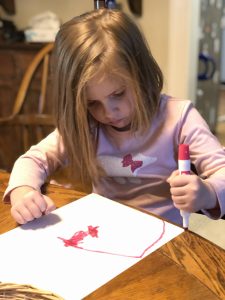
Play, play and more play
Cat is building skills in too many areas to list. She spends day in and day out working out the puzzle that is her world and her existence. This is difficult and complex work that all young children grapple with for years on end. In many ways it is far more challenging than anything we adults ever do. And they do almost all of this learning and growth, all this work, when they are playing. (And the rest they do while they are sleeping) In my role as Cat’s teacher, I do not focus on teaching her things. Instead, I focus on facilitating and encouraging unstructured and open-ended play. I provide materials that I hope will foster this creative play time. If Cat is engaged in play, I schedule my routine around it. Play is near the top of my priority list when it comes to planning our days. Whenever possible, I allow play to continue to its natural end, even if that means it goes on for hours.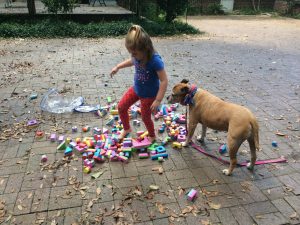
Lots and Lots of Outside Time
Time spent outdoors is extremely high on my list of priorities. Like play, unstructured outside time has show over and over again to be critical to a child’s health and development. So we spend time in the yard. We visit farms and parks, forests and playgrounds. I aim for a minimum of 3 hours outside a day, but that’s a flexible target. Sometimes we end up outside a lot less, sometimes a lot more. Cat has a great deal of choice in the matter, but she is passionate about outside activities, so the only real barrier to getting us out is my own resistance. Getting past my resistance and getting out into the sun is always, always worth it.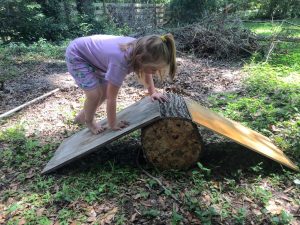
Out and About – Connecting with our community
Cat’s socioemotional development is as important to me as her development in all other areas, perhaps more important. So we socialize. We go out into the world and meet the people we find there. Cat regularly interacts with people of all ages, from infants to the elderly. We take a package to the post office and strike up a conversation with the mailman. We schedule play dates with friends and lunch dates with grandma. The children’s librarian knows us by name. The idea of ‘stranger danger’ has proven to do more harm than good, so we don’t bother. Cat doesn’t live in a world of strangers, she lives in a world of friends. And she connects happily with them every opportunity she gets. We are well aware that there are people in her world that would choose to harm her given the opportunity. But at four years old, she’s virtually always in the company of a parent or caretaker.Our message to her that ‘your world is safe’ will adapt and grow as she does, and we will introduce new ideas as needed.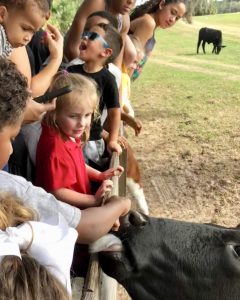
No screen time limits
In our family, screen time is embraced as a fantastic educational tool as well as great entertainment. We use it regularly, and balance it with a myriad of other activity choices. Cat chooses how much she consumes. We do impose some soft limits on content, ensuring that it is appropriate for Cat’s age. The research I’ve seen that says screen time is harmful is questionable at best. Since there isn’t currently enough reason to worry, we’re not worried.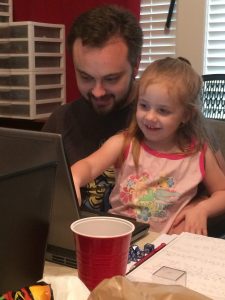
Embracing hygiene hypothesis
There are a lot of societal rules regarding dirt and germs. For the most part, we disregard them entirely. There is a growing body of research that shows that early exposure to a variety of germs actually serves a protective function. It’s good for babies to eat dirt. Eating food off the floor? Totally fine. Boogers? Basically a health food. There’s not enough evidence that stressing about such things is worth the conflict and effort, so most of the time we don’t bother. In addition to being relatively unconcerned about germs, as a general rule we do not intervene when Cat chooses to get messy, and we often encourage it. She often chooses to play in the mud up to her shoulders or use herself as a canvas for her paint. Fine with us. Clean up never takes as long as I expect it to. We do encourage frequent handwashing, and impose boundaries when there’s a enough reason to believe that what she’s doing could impose a real health hazard. We also talk to Cat about why it might be best to follow societal expectations when she’s around others, as well as take actions to promote health in our community.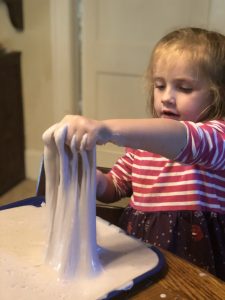
Embracing Risk
We allow and encourage risk-taking. I have come to view play that involves some element of risk to be a critical component of healthy development. Cat climbs and jumps, runs around outside in bare feet, and uses knives and power tools. While she is allowed far more freedom in terms of risk-taking than most of her peers, we do place some limits on the risks that Cat is allowed to take. Basically, if I believe that Cat is capable of understanding the risk that she is taking, she is allowed to take the risk. Cat loves risky play, but she has learned that danger is real, and is getting better at better at assessing those risks for herself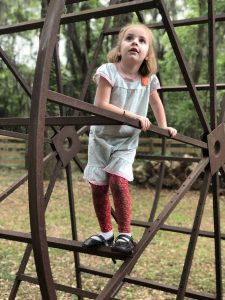
This is an outline of our basic parenting practices – the way we want to parent. The standards that we do our best to hold ourselves to. We do not always succeed. We are constantly striving to learn more and do a better job of parenting with patience, love and logic. But we find it helpful to have clear goals in place in the moments where parenting is at its most difficult.


I strongly agree with everything you have written here. I remember being inspired by A. S. Neill’s Summerhill philosophies (the school he founded in England emphasizing freedom) when I was raising my sons. You have eloquently given voice to these childrearing techniques, and I am please Cat (along with Remy and Leo) are the beneficiaries of Unschooling.